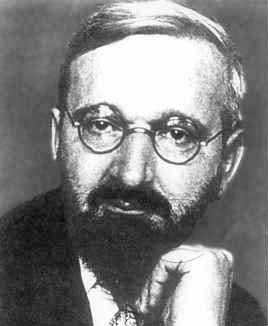<Back to Index>
- Mathematician and Physicist Theodor Franz Eduard Kaluza, 1885
PAGE SPONSOR


Theodor Franz Eduard Kaluza (9 November 1885, Wilhelmsthal – 19 January 1954, Göttingen) was a German mathematician and physicist known for the Kaluza - Klein theory involving field equations in five - dimensional space. His idea that fundamental forces can be unified by introducing additional dimensions re-emerged much later in string theory.
Kaluza was born to a Roman Catholic family from the town of Ratibor in the German Empire's Prussian Province of Silesia. Kaluza himself was born in Wilhelmsthal (a village that was incorporated into Oppeln (present day Opole) in 1899). He spent his youth in Königsberg, where his father, Max Kaluza, was a professor of the English language. He entered the University of Königsberg to study mathematics and gained his doctorate with a thesis on Tschirnhaus transformations. Kaluza was primarily a mathematician but began studying relativity. In April 1919 Kaluza noticed that when he solved Albert Einstein's equations for general relativity using five dimensions, then James Clark Maxwell's equations for electromagnetism emerged spontaneously. Kaluza wrote to Einstein who, in turn, encouraged him to publish. Kaluza's theory was published in 1921 in a paper, "Zum Unitätsproblem der Physik" with Einstein's support in Sitzungsberichte Preußische Akademie der Wissenschaften 96, 69. (1921).
Kaluza's insight is remembered as the Kaluza - Klein theory (also named after physicist Oskar Klein). However, the work was neglected for many years as attention was directed towards quantum mechanics. His idea that fundamental forces can be explained by additional dimensions did not re-emerge until string theory was developed. It is however also notable that many of the aspects of this body of work were already published in 1914 by Gunnar Nordström, but his work also went unnoticed and was not recognized when the ideas re-emerged.
For the rest of his career Kaluza continued to produce ideas about relativity and about models of the atomic nucleus. Despite Einstein's support, Kaluza remained at a low rank (Privatdozent) at Königsberg until 1929 when he was appointed as professor at the University of Kiel. In 1935 he became a full professor at the University of Göttingen where he remained until his death in 1954. Perhaps his finest mathematical work is the textbook Höhere Mathematik für die Praktiker which was written jointly with Georg Joos.
Kaluza was extraordinarily versatile. He spoke or wrote 17 languages (his favorite allegedly Arabic). He also had an unusually modest personality. He refused the National Socialist ideology and his appointment to the Göttingen chair was possible only with difficulties and by protection of his colleague Helmut Hasse. Strange stories were told of his private life, for example, that he taught himself to swim in his thirties by reading a book and succeeded at his first attempt in water.
Kaluza had a son (born 1910), also named Theodor Kaluza, who was a notable mathematician.